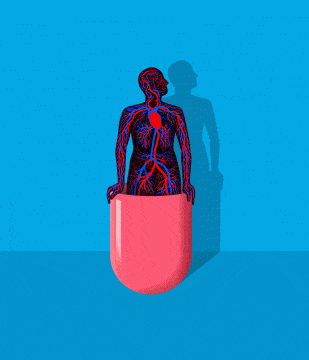Siddhartha Mukherjee in The New Yorker:
 It matters that the first patients were identical twins. Nancy and Barbara Lowry were six years old, dark-eyed and dark-haired, with eyebrow-skimming bangs. Sometime in the spring of 1960, Nancy fell ill. Her blood counts began to fall; her pediatricians noted that she was anemic. A biopsy revealed that she had a condition called aplastic anemia, a form of bone-marrow failure. The marrow produces blood cells, which need regular replenishing, and Nancy’s was rapidly shutting down. The origins of this illness are often mysterious, but in its typical form the spaces where young blood cells are supposed to be formed gradually fill up with globules of white fat. Barbara, just as mysteriously, was completely healthy. The Lowrys lived in Tacoma, a leafy, rain-slicked city near Seattle. At Seattle’s University of Washington hospital, where Nancy was being treated, the doctors had no clue what to do next. So they called a physician-scientist named E. Donnall Thomas, at the hospital in Cooperstown, New York, asking for help.
It matters that the first patients were identical twins. Nancy and Barbara Lowry were six years old, dark-eyed and dark-haired, with eyebrow-skimming bangs. Sometime in the spring of 1960, Nancy fell ill. Her blood counts began to fall; her pediatricians noted that she was anemic. A biopsy revealed that she had a condition called aplastic anemia, a form of bone-marrow failure. The marrow produces blood cells, which need regular replenishing, and Nancy’s was rapidly shutting down. The origins of this illness are often mysterious, but in its typical form the spaces where young blood cells are supposed to be formed gradually fill up with globules of white fat. Barbara, just as mysteriously, was completely healthy. The Lowrys lived in Tacoma, a leafy, rain-slicked city near Seattle. At Seattle’s University of Washington hospital, where Nancy was being treated, the doctors had no clue what to do next. So they called a physician-scientist named E. Donnall Thomas, at the hospital in Cooperstown, New York, asking for help.
In the nineteen-fifties, Thomas had attempted a new kind of therapy, in which he infused a leukemia patient with marrow extracted from the patient’s healthy identical twin. There was fleeting evidence that the donated marrow cells had “engrafted” into the patient’s bones, but the patient had swiftly relapsed. Thomas had tried to refine the transplant protocol on dogs, with some marginal success. Now the Seattle doctors persuaded him to try again in humans. Nancy’s marrow was faltering, but no malignant cells were occupying it. Would the blood stem cells from one twin’s marrow “take” in the other twin? Thomas flew to Seattle. On August 12, 1960, Barbara was sedated, and her hips and legs were punctured fifty times with a large-bore needle to extract the crimson sludge of her bone marrow. The marrow, diluted in saline, was then dripped into Nancy’s bloodstream. The doctors waited. The cells homed their way into her bones and gradually started to produce normal blood. By the time she was discharged, her marrow had been almost completely reconstituted. Nancy emerged as a living chimera: her blood, in a sense, belonged to her twin.
More here.
